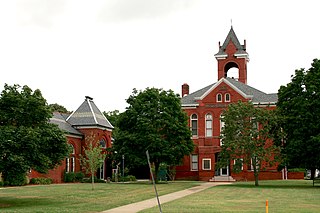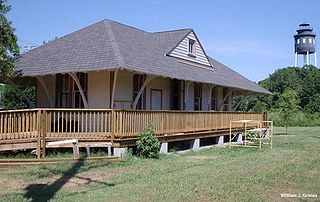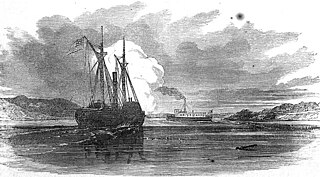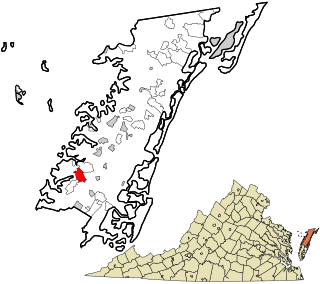
Accomac is a town in Accomack County, Virginia, United States. The population was 519 at the 2010 census. It is the county seat of Accomack County.

Saxis is a town in Accomack County, Virginia, United States. The population was 241 at the 2010 census.

The Pocomoke River stretches approximately 66 miles (106 km) from southern Delaware through southeastern Maryland in the United States. At its mouth, the river is essentially an arm of Chesapeake Bay, whereas the upper river flows through a series of relatively inaccessible wetlands called the Great Cypress Swamp, largely populated by Loblolly Pine, Red Maple and Bald Cypress. The river is the easternmost river that flows into Chesapeake Bay. "Pocomoke", though traditionally interpreted as "dark water" by local residents, is now agreed by scholars of the Algonquian languages to be derived from the words for "broken ground."

The Eastern Shore of Virginia consists of two counties on the Atlantic coast detached from the mainland of the Commonwealth of Virginia in the United States. The 70-mile-long (110 km) region is part of the Delmarva Peninsula and is separated from the rest of Virginia by the Chesapeake Bay. Its population was 45,553 as of 2010.

CSS Teaser had been the aging Georgetown, D.C. tugboat York River until the beginning of the American Civil War, when she was taken into the Confederate States Navy and took part in the famous Battle of Hampton Roads. Later, she was captured by the United States Navy and became the first USS Teaser.

Nansemond is an extinct locality that was located in Virginia Colony and the Commonwealth of Virginia in the United States, from 1646 until 1974. It was Nansemond County until 1972, and the independent city of Nansemond from 1972 to 1974. It is now part of the independent city of Suffolk.

Piscataway is an unincorporated community in Prince George's County, Maryland, United States. It is one of the oldest European-colonized communities in the state. The Piscataway Creek provided sea transportation for export of tobacco. It is located near the prior Piscataway tribe village of Kittamaqundi.

Croaker is an unincorporated community in James City County, Virginia, United States on the south bank of the York River 10 miles downstream from West Point. The York River is formed from the confluence of the Mattaponi River and the Pamunkey River at West Point. The York River empties into the Chesapeake Bay about 30 miles downstream from Croaker.

The Bay Coast Railroad operated the former Eastern Shore Railroad line from Pocomoke City, Maryland, to Norfolk, Virginia. The Bay Coast Railroad interchanged with the Norfolk Southern Railway at Norfolk, Virginia and the Delmarva Central Railroad at Pocomoke City, Maryland. Following the lease of 162 miles of Norfolk Southern track on the Delmarva peninsula by the Delmarva Central Railroad in December 2016, the interchange changed from NS to the DCR.

Shockoe Bottom is an area in Richmond, Virginia, just east of downtown, along the James River. Located between Shockoe Hill and Church Hill, Shockoe Bottom contains much of the land included in Colonel William Mayo's 1737 plan of Richmond, making it one of the city's oldest neighborhoods.

State Route 178 is a primary state highway in the U.S. state of Virginia. The state highway runs 11.51 miles (18.52 km) from U.S. Route 13 Business in Exmore north to SR 620, SR 628, and SR 718 at Bobtown. SR 178 connects Exmore in far northern Northampton County with Belle Haven and Pungoteague in southern Accomack County.

State Route 180 is a primary state highway in the U.S. state of Virginia. The state highway runs 11.25 miles (18.11 km) from a dead end in Harborton east to SR 1701 in Wachapreague. SR 180 is a cross-peninsula highway in southern Accomack County that passes through Pungoteague and Keller, where the highway meets U.S. Route 13.

The pungy is a type of schooner developed in and peculiar to the Chesapeake Bay region. The name is believed to derive from the Pungoteague region of Accomack County, Virginia, where the design was developed in the 1840s and 1850s.

Pungoteague is a census-designated place (CDP) in Accomack County, Virginia, United States. The population as of the 2010 Census was 347.

Howardsville is an unincorporated community in Albemarle County, Virginia.
Mattox Creek is a tributary of the Potomac River in the Washington District of Westmoreland County, Virginia, near the colonial stagecoach stop of Oak Grove. The creek is 13.9 miles (22.4 km) long, and the lower 3 miles (5 km) of the creek is navigable. It lies between, and only minutes from, the birthplaces of George Washington and James Monroe.

St. George's Church is a historic Episcopal Church on VA 178, northeast of the junction with VA 180 in Pungoteague, Accomack County, Virginia. Established in the seventeenth century, the building, erected in 1738, is the oldest house of worship standing on Virginia's Eastern Shore. The church was added to the National Register of Historic Places in 1970.

The Tobacco Inspection Act of 1730 was a 1730 English law designed to improve the quality of tobacco exported from Colonial Virginia. Proposed by Virginia Lieutenant Governor Sir William Gooch, the law was far-reaching in impact in part because it gave warehouses the power to destroy substandard crops and issue bills of exchange that served as currency. The law centralized the inspection of tobacco at 40 locations described in the law.






















